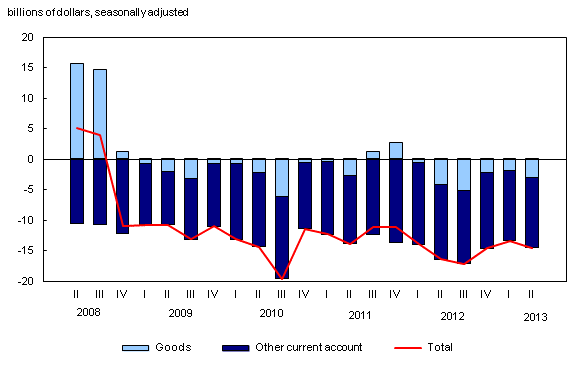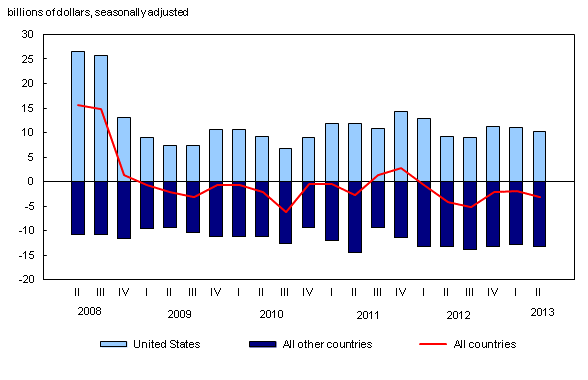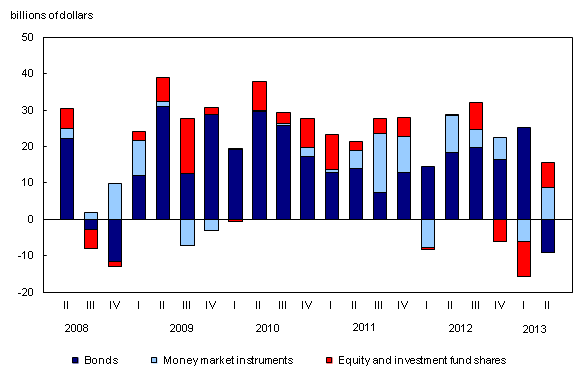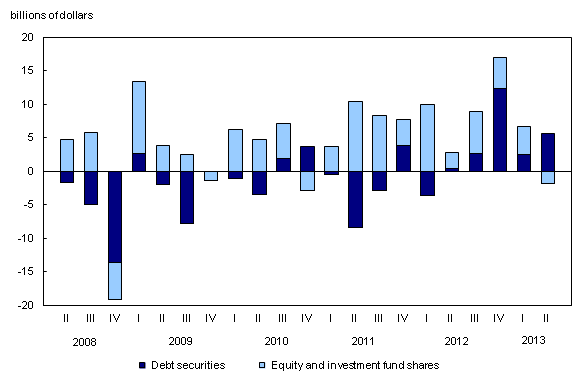Canada's balance of international payments, second quarter 2013
Archived Content
Information identified as archived is provided for reference, research or recordkeeping purposes. It is not subject to the Government of Canada Web Standards and has not been altered or updated since it was archived. Please "contact us" to request a format other than those available.
Released: 2013-08-29
Canada's current account deficit (on a seasonally adjusted basis) increased $1.1 billion to $14.6 billion in the second quarter. This change was largely reflected in the trade balance, led by a higher deficit on trade in goods.
In the financial account (unadjusted for seasonal variation), foreign direct and portfolio investors continued to inject funds into the Canadian economy but down compared with the first quarter. Canadian investment abroad also moderated in the quarter.
Current account
Deficit on trade in goods widens
The deficit on trade in goods expanded $1.1 billion in the second quarter to $3.1 billion, as imports increased. The surplus with the United States was reduced during the quarter as imports grew more than exports. The drop in energy exports to the United States largely offset gains in other categories.
Total imports of goods advanced $1.4 billion to $121.3 billion in the second quarter. Motor vehicles and parts increased $0.7 billion on higher volumes of cars, trucks and parts. Electronic and electrical equipment rose $0.6 billion on higher volumes of communications equipment and of electronic and electric parts. However, resources dampened overall import activity in the quarter. Metal ores and non-metallic minerals lost $0.5 billion, reflecting lower volumes of metal ores. Energy products were also lower, edging down $0.1 billion. Lower volumes of crude petroleum were mostly offset by the increase of refined petroleum products.
Total exports of goods edged up $0.2 billion to $118.2 billion during the second quarter. Motor vehicles and parts were up $0.7 billion, as the volume of cars exported increased. Aircraft and other transportation equipment advanced $0.3 billion on higher volumes for aircraft. Electronic and electrical equipment as well as consumer goods were each up $0.2 billion. Energy moderated some of these gains. Exports of energy product were down $0.8 billion, mainly because of lower volumes of crude petroleum. Farm, fishing and intermediate food products declined by $0.4 billion, resulting from lower volumes of wheat and canola.
Trade in services deficit edges up
The deficit on trade in services edged up $0.2 billion to $6.2 billion in the second quarter. The deficit on transportation services expanded, as payments for water transport were up in the quarter. The travel deficit was also up slightly. However, this was partly offset by a higher surplus in trade in commercial services, as exports declined less than imports.
Investment income deficit expands
The deficit on investment income expanded $0.2 billion to $4.2 billion in the second quarter. Earnings of Canadian direct investors abroad increased $0.4 billion while those of foreign direct investors in Canada were up $0.2 billion. However, payments to foreign holders of Canadian securities advanced $0.3 billion, notably on higher interest paid on private corporate bonds.
Lower deficit in secondary income flows
The deficit in transactions on secondary income was reduced by $0.5 billion in the second quarter. This largely reflected higher receipts by Canadian insurance companies on reinsurance services provided by foreign insurers, arising from the Alberta flood in June of this year.
Financial account
Foreign investment in Canadian securities slows for a third straight quarter
Foreign investment in Canadian securities slowed for a third straight quarter, reaching $6.3 billion in the second quarter, the lowest level in more than a year. Foreign investors purchased money market instruments and equities, but reduced their holdings of bonds.
Foreign investment in the Canadian money market was $8.9 billion, more than offsetting the divestment in these instruments in the first quarter. Inflows targeted US dollar provincial government paper and, to a lesser extent, corporate paper.
Non-resident investors also added $6.7 billion of Canadian equities to their holdings in the second quarter, with two-thirds acquired on the secondary market. This activity followed two straight quarters of divestment in these instruments. The Canadian stock market declined by 4.9% in the quarter.
Foreign investors' holdings of Canadian bonds were down by $9.2 billion in the second quarter, marking the first divestment since 2008. This activity was led by retirements of federal government and federal business enterprise bonds, mainly Canadian dollar-denominated instruments. Foreign acquisitions of new US dollar-denominated private corporate bonds moderated the overall reduction in the quarter. Non-resident investors' holdings of private corporate bonds were up 7.2% in the second quarter. A large portion of these bonds are denominated in US dollars. Canadian long-term interest rates increased by 74 basis points while the Canadian dollar continued to depreciate against the US dollar, closing the quarter at its lowest level in three years.
Canadian investment in foreign securities focuses on debt instruments
Canadian investment in foreign securities slowed to $3.8 billion in the second quarter, the lowest in a year. Canadian investors favoured debt instruments in the quarter, selling equities for the first time since 2010.
Canadians purchased $5.6 billion of foreign debt securities, marking the fifth straight quarter of investment in these instruments. This activity mostly reflected acquisitions of non-US foreign bonds and US Treasury bills. Long-term interest rates in the United States rose in the quarter, but at a slower pace than in Canada.
Canadian holdings of foreign equities were reduced by $1.9 billion. Sales were focused on US equities and were moderated by acquisitions of non-US foreign equities. US stock prices were up 2.7% in the second quarter.
Inward and outward direct investment activity moderates
Foreign direct investment in Canada was $11.8 billion in the second quarter, down from $19.6 billion in the previous quarter. Lower cross-border merger and acquisition activity contributed to reduced inflows in the quarter. The manufacturing as well as the energy and mining sectors accounted for the bulk of the foreign direct investment in the country over the quarter.
Canadian direct investment abroad of $4.1 billion in the second quarter was the lowest in two years. On a geographical basis, funds were primarily directed to the United States. Direct investment outflows have slowed steadily over the last three quarters, and this weakness was widespread across most industries.
Note to readers
The balance of international payments covers all economic transactions between Canadian residents and non-residents in three accounts: the current account, the capital account, and the financial account.
The current account covers transactions in goods, services, compensation of employees, investment income and secondary income (current transfers).
The current account data in this release are seasonally adjusted. For more information on seasonal adjustment, see Seasonal adjustment and identifying economic trends.
The capital account covers capital transfers and transactions in non-produced non-financial assets.
The financial account comprises transactions in financial assets and liabilities.
In principle, a net lending (+) / net borrowing (-) derived from the sum of the current and capital accounts corresponds to a net lending (+) / net borrowing (-) derived from the financial account. In practice, as data are compiled from multiple sources, this is rarely the case and gives rise to measurement error. The discrepancy (net errors and omissions) is the unobserved net inflow or outflow.
For more information about the balance of payments, consult the "Frequently asked questions" section in the National economic accounts module of our website. The module also presents the most recent balance of payments statistics.
The balance of international payments data for the third quarter will be released on November 28.
Contact information
For more information, contact us (toll-free 1-800-263-1136; infostats@statcan.gc.ca).
To enquire about the concepts, methods or data quality of this release, contact Denis Caron (613-951-1861; denis.caron@statcan.gc.ca), International Accounts and Statistics Division.
- Date modified:





